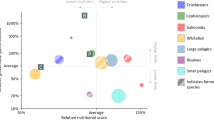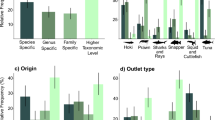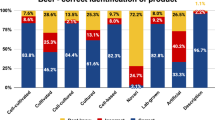Abstract
Slow growth in the bivalve mariculture sector results from production inefficiencies, food safety concerns, limited availability of convenience products and low consumer demand. Here we assess whether bivalves could meet mass-market seafood demand across the bivalve value chain. We explore how bivalve production could become more efficient, strategies for increasing edible meat yield and how food safety could be improved through food processing technologies and new depuration innovations. Finally, we examine barriers to consumer uptake, such as food allergen prevalence and bivalve preparation challenges, highlighting that appealing and convenient bivalve food products could provide consumers with nutritious and sustainable seafood options—and contribute positively to global food systems.
This is a preview of subscription content, access via your institution
Access options
Access Nature and 54 other Nature Portfolio journals
Get Nature+, our best-value online-access subscription
$29.99 / 30 days
cancel any time
Subscribe to this journal
Receive 12 digital issues and online access to articles
$119.00 per year
only $9.92 per issue
Buy this article
- Purchase on Springer Link
- Instant access to full article PDF
Prices may be subject to local taxes which are calculated during checkout





Similar content being viewed by others
References
The State of World Fisheries and Aquaculture 2020 (FAO, 2020); https://doi.org/10.4060/ca9229en
Costello, C. et al. The future of food from the sea. Nature https://doi.org/10.1038/s41586-020-2616-y (2020).
Malcorps, W. et al. The sustainability conundrum of fishmeal substitution by plant ingredients in shrimp feeds. Sustainability 11, 1212 (2019).
Cashion, T., le Manach, F., Zeller, D. & Pauly, D. Most fish destined for fishmeal production are food-grade fish. Fish Fish. 18, 837–844 (2017).
Willer, D. F. & Aldridge, D. C. Microencapsulated diets to improve bivalve shellfish aquaculture for global food security. Glob. Food Secur. 23, 64–73 (2019).
Naylor, R. L. et al. A 20-year retrospective review of global aquaculture. Nature 591, 551–563 (2021).
Campanati, C., Willer, D. F., Schubert, J. & Aldridge, D. C. Sustainable intensification of aquaculture through nutrient recycling and circular economies: more fish, less waste, blue growth. Rev. Fish. Sci. Aquacult. https://doi.org/10.1080/23308249.2021.1897520 (2021).
Belton, B. et al. Farming fish in the sea will not nourish the world. Nat. Commun. 11, 5804 (2020).
Willett, W. et al. Food in the Anthropocene: the EAT–Lancet Commission on healthy diets from sustainable food systems. Lancet 393, 447–492 (2019).
Willer, D. F. & Aldridge, D. C. Sustainable bivalve farming can deliver food security in the tropics. Nat. Food 1, 384–388 (2020).
Pelletier, N. L. et al. Impact categories for life cycle assessment research of seafood production systems: review and prospectus. Int. J. Life Cycle Assess. 12, 414–421 (2007).
Turolla, E., Castaldelli, G., Fano, E. A. & Tamburini, E. Life cycle assessment (LCA) proves that Manila clam farming (Ruditapes philippinarum) is a fully sustainable aquaculture practice and a carbon sink. Sustainability 12, 5252 (2020).
Yield and Nutritional Value of the Commercially More Important Fish Species FAO Fisheries Technical Paper 309 (FAO, 1989).
Fulton, S. Fish and Fuel: Life Cycle Greenhouse Gas Emissions Associated with Icelandic Cod, Alaskan Pollock, and Alaskan Pink Salmon Fillets delivered to the United Kingdom. MSc thesis, Dalhousie Univ. (2010).
Hospido, A. & Tyedmers, P. Life cycle environmental impacts of Spanish tuna fisheries. Fish. Res. 76, 174–186 (2005).
Edwards, P., Zhang, W., Belton, B. & Little, D. C. Misunderstandings, myths and mantras in aquaculture: its contribution to world food supplies has been systematically over reported. Mar. Policy 106, 103547 (2019).
Tamburini, E., Fano, E. A., Castaldelli, G. & Turolla, E. Life cycle assessment of oyster farming in the Po Delta, northern Italy. Resources 8, 170 (2019).
Willer, D. F. & Aldridge, D. C. Microencapsulated diets to improve growth and survivorship in juvenile European flat oysters (Ostrea edulis). Aquaculture 505, 256–262 (2019).
Botta, R., Asche, F., Borsum, J. S. & Camp, E. V. A review of global oyster aquaculture production and consumption. Mar. Policy 117, 103952 (2020).
Tamburini, E., Turolla, E., Fano, E. A. & Castaldelli, G. Sustainability of mussel (Mytilus galloprovincialis) farming in the Po River Delta, northern Italy, based on a life cycle assessment approach. Sustainability 12, 3814 (2020).
Hamilton, H. A., Newton, R., Auchterlonie, N. A. & Müller, D. B. Systems approach to quantify the global omega-3 fatty acid cycle. Nat. Food 1, 59–62 (2020).
FoodData Central (United States Department of Agriculture Agricultural Research Service, 2020); https://fdc.nal.usda.gov
Mensink, G. B. M. et al. Mapping low intake of micronutrients across Europe. Brit. J. Nutr. 110, 755–773 (2013).
Avdelas, L. et al. The decline of mussel aquaculture in the European Union: causes, economic impacts and opportunities. Rev. Aquacult. https://doi.org/10.1111/raq.12465 (2020).
Xu, C., Li, Q., Chong, J., Liu, S. & Kong, L. Mass selection for growth improvement in black shell line of Pacific oyster Crassostrea gigas. J. Ocean Univ. China 18, 1411–1416 (2019).
Frösell, M. Mussel Farming Using Various Techniques Evaluated Using Life Cycle Assessment (LCA). MSc thesis, Swedish Univ. Agricultural Sciences (2019).
Willer, D. F., Furse, S. & Aldridge, D. C. Microencapsulated algal feeds as a sustainable replacement diet for broodstock in commercial bivalve aquaculture. Sci. Rep. 10, 12577 (2020).
Farmery, A. K. et al. Blind spots in visions of a "blue economy" could undermine the oceanas contribution to eliminating hunger and malnutrition. One Earth 4, 28–38 (2021).
Froehlich, H. E., Gentry, R. R. & Halpern, B. S. Global change in marine aquaculture production potential under climate change. Nat. Ecol. Evol. 2, 1745–1750 (2018).
Gentry, R. R. et al. Mapping the global potential for marine aquaculture. Nat. Ecol. Evol. 1, 1317–1324 (2017).
Edwards, P. Aquaculture environment interactions: past, present and likely future trends. Aquaculture 447, 2–14 (2015).
van der Schatte Olivier, A. et al. A global review of the ecosystem services provided by bivalve aquaculture. Rev. Aquacult. 12, 3–25 (2018).
Ray, N. E., O’Meara, T., Wiliamson, T., Izursa, J. L. & Kangas, P. C. Consideration of carbon dioxide release during shell production in LCA of bivalves. Int. J. Life Cycle Assess. 23, 1042–1048 (2018).
Wijsman, J. W. M., Troost, K., Fang, J. & Roncarati, A. in Goods and Services of Marine Bivalves (eds Smaal, A. C. et al.) 7–26 (Springer International Publishing, 2019); https://doi.org/10.1007/978-3-319-96776-9_2
el Biriane, M. & Barbachi, M. State-of-the-art review on recycled mussel shell waste in concrete and mortar. Innov. Infrastruct. Solut. 6, 29 (2021).
Gjedrem, T., Robinson, N. & Rye, M. The importance of selective breeding in aquaculture to meet future demands for animal protein: a review. Aquaculture 350–353, 117–129 (2012).
Love, D. C. et al. Performance and conduct of supply chains for United States farmed oysters. Aquaculture 515, 734569 (2020).
Martinez-Albores, A. et al. Complementary methods to improve the depuration of bivalves: a review. Foods 9, 129 (2020).
Willis, J. E., McClure, J. T., Davidson, J., McClure, C. & Greenwood, S. J. Global occurrence of Cryptosporidium and Giardia in shellfish: should Canada take a closer look? Food Res. Int. 52, 119–135 (2013).
Garrido Gamarro, E., Ryder, J., Elvevoll, E. O. & Olsen, R. L. Microplastics in fish and shellfish–a threat to seafood safety? J. Aquat. Food Prod. Technol. 29, 417–425 (2020).
Baptista, R. C., Rodrigues, H. & Sant’Ana, A. S. Consumption, knowledge, and food safety practices of Brazilian seafood consumers. Food Res. Int. 132, 109084 (2020).
Wright, A. C., Fan, Y. & Baker, G. L. Nutritional value and food safety of bivalve molluscan shellfish. J. Shellfish Res. 37, 695–708 (2018).
Food Availability (Per Capita) Data System (USDA Economic Research Service, 2018); https://www.ers.usda.gov/data-products/food-availability-per-capita-data-system/
Hassan, F., Geethalakshmi, V., Jeeva, J. C. & Babu, M. R. Combined effect of lime (Citrus aurantitolia) and drying on reducing bacteria of public health significance in edible Oyster (Crassostrea madrasensis). J. Food Sci. Technol. 50, 203–207 (2013).
Teng, X. et al. Implementing marine functional zoning in China. Mar. Policy https://doi.org/10.1016/j.marpol.2019.02.055 (2019).
Mao, Y. et al. in Goods and Services of Marine Bivalves (eds Smaal, A. C. et al.) 51–72 (Springer International Publishing, 2019); https://doi.org/10.1007/978-3-319-96776-9_4
Bonfim, R. C., de Oliveira, F. A., Godoy, R. L., de, O. & Rosenthal, A. A review on high hydrostatic pressure for bivalve mollusk processing: relevant aspects concerning safety and quality. Food Sci. Technol. 39, 515–523 (2019).
Huang, H. W., Wu, S. J., Lu, J. K., Shyu, Y. T. & Wang, C. Y. Current status and future trends of high-pressure processing in food industry. Food Contr. 72, 1–8 (2017).
Truong, B. Q., Buckow, R., Stathopoulos, C. E. & Nguyen, M. H. Advances in high-pressure processing of fish muscles. Food Eng. Rev. 7, 109–129 (2015).
Chile National Statistics Database (Instituto Nacional de Estadísticas, 2021); https://www.ine.cl/estadisticas/economia/indices-de-precio-e-inflacion/indice-de-precios-al-consumidor
Merdzhanova, A., Panayotova, V., Dobreva, D. A. & Stancheva, R. Effect of thermal stress on the biologically active lipids of Mytilus galloprovincialis. Bulg. Chem. Commun. 51, 256–261 (2019).
Woodhead, S. F. in A Complete Course in Canning and Related Processes 14th edn, Vol. 3 (ed. Featherstone, S.) 231–265 (Woodhead Publishing, 2016).
Iribarren, D., Hospido, A., Moreira, M. T. & Feijoo, G. Carbon footprint of canned mussels from a business-to-consumer approach. A starting point for mussel processors and policy makers. Environ. Sci. Policy 13, 509–521 (2010).
Smetana, S. et al. Structure design of insect-based meat analogs with high-moisture extrusion. J. Food Eng. 229, 83–85 (2018).
Loveday, S. M. Food proteins: technological, nutritional, and sustainability attributes of traditional and emerging proteins. Annu. Rev. Food Sci. Technol. 10, 311–339 (2019).
Smetana, S., Mathys, A., Knoch, A. & Heinz, V. Meat alternatives: life cycle assessment of most known meat substitutes. Int. J. Life Cycle Assess. 20, 1254–1267 (2015).
Millman, B. M. Mechanisms of contraction in molluscan muscle. Am. Zool. 7, 583–591 (1967).
Willer, D. F. & Aldridge, D. C. From pest to profit-the potential of shipworms for sustainable aquaculture. Front. Sustain. Food Syst. 4, 575416 (2020).
Messina, M. & Venter, C. Recent surveys on food allergy prevalence. Nutr. Today 55, 22–29 (2020).
Davis, C. M. et al. Clinical management of seafood allergy. J. Allergy Clin. Immunol. 8, 37–44 (2020).
Wong, L., Tham, E. H. & Lee, B. W. An update on shellfish allergy. Curr. Opin. Allergy Clin. Immunol. 19, 236–242 (2019).
Ruethers, T. et al. Seafood allergy: a comprehensive review of fish and shellfish allergens. Mol. Immunol. 100, 28–57 (2018).
Wai, C. Y. Y. et al. Overcoming shellfish allergy: how far have we come? Int. J. Mol. Sci. 21, 2234 (2020).
Warren, C. M., Aktas, O. N., Gupta, R. S. & Davis, C. M. Prevalence and characteristics of adult shellfish allergy in the United States. J. Allergy Clin. Immunol. 144, 1435–1438.e5 (2019).
Franco, S. C., Kuznesof, S., Simoes, B., Clark, B. & Jackson, P. What Do People Think of Aquaculture? Exploring Perceptions and Beliefs of Aquaculture and its Products (Scottish Association for Marine Science, 2019).
Ponce Oliva, R. D. et al. Ocean acidification, consumers’ preferences, and market adaptation strategies in the mussel aquaculture industry. Ecol. Econ. 158, 42–50 (2019).
Anacleto, P., Barrento, S., Nunes, M. L., Rosa, R. & Marques, A. Portuguese consumers’ attitudes and perceptions of bivalve molluscs. Food Contr. 41, 168–177 (2014).
Lawley, M. & Birch, D. Exploring point of sale strategies for improving seafood retailing: the case of the Australian oyster industry. J. Food Prod. Market. 22, 792–808 (2016).
Mueller Loose, S., Peschel, A. & Grebitus, C. Quantifying effects of convenience and product packaging on consumer preferences and market share of seafood products: the case of oysters. Food Qual. Prefer. 28, 492–504 (2013).
Fabinyi, M. & Liu, N. The social context of the Chinese food system: an ethnographic study of the Beijing seafood market. Sustainability 8, 244 (2016).
Barone, R. S. C., Lorenz, E. K., Sonoda, D. Y. & Cyrino, J. E. P. Fish and fishery products trade in Brazil, 2005 to 2015: a review of available data and trends. Sci. Agric. 74, 417–424 (2017).
Khan, A. S. & Sesay, S. S. S. Seafood insecurity, bush meat consumption, and public health emergency in West Africa: did we miss the early warning signs of an Ebola epidemic? Mar. Stud. 14, 3 (2015).
Acknowledgements
We thank the team at Nomad Foods for supporting R.J.N. in arranging the consumer panel, and for their feedback on the manuscript before submission. D.F.W. is supported by the Department of Zoology and a Henslow Fellowship at Murray Edwards College, University of Cambridge. R.J.N. is funded by Nomad Foods. D.C.A. is supported by a Dawson Fellowship at St Catharine’s College, Cambridge.
Author information
Authors and Affiliations
Contributions
D.F.W., R.J.N. and D.C.A. all participated in study design and data analysis. D.F.W. wrote the final manuscript. All authors reviewed and approved the manuscript before submission.
Corresponding author
Ethics declarations
Competing interests
R.J.N. is an employee of Nomad Foods. All other authors have no competing interests.
Additional information
Peer review information Nature Food thanks Kate Barclay and the other, anonymous, reviewer(s) for their contribution to the peer review of this work.
Publisher’s note Springer Nature remains neutral with regard to jurisdictional claims in published maps and institutional affiliations.
Supplementary information
Supplementary Information
Supplementary Figs. 1–2 and Discussion.
Supplementary Table 1
List of questions asked and full results from the online consumer panel.
Supplementary Data 1
Numerical source data for Fig. 1.
Supplementary Data 2
Numerical source data for Fig. 2.
Supplementary Data 3
Numerical source data for Fig. 3.
Rights and permissions
About this article
Cite this article
Willer, D.F., Nicholls, R.J. & Aldridge, D.C. Opportunities and challenges for upscaled global bivalve seafood production. Nat Food 2, 935–943 (2021). https://doi.org/10.1038/s43016-021-00423-5
Received:
Accepted:
Published:
Issue Date:
DOI: https://doi.org/10.1038/s43016-021-00423-5
This article is cited by
-
Wild fish consumption can balance nutrient retention in farmed fish
Nature Food (2024)
-
Aquatic foods at the nutrition–environment nexus
Nature Sustainability (2023)
-
Naked Clams to open a new sector in sustainable nutritious food production
npj Sustainable Agriculture (2023)



